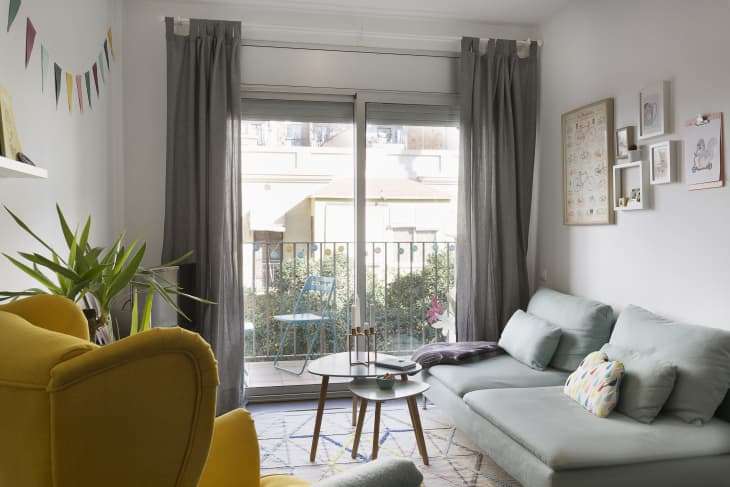Decorating isn’t cheap, especially when it comes to shopping for furnishings and finishes that are stylish, durable, and comfortable. Finding all of those qualities in a single piece for a sensible price is a little bit like finding a diamond in the rough, but it’s doable. And if anyone knows how to stretch a dollar, it’s a designer. I mean, no clients are ever mad when their project comes in under budget, right? Designers always have a few tricks up their sleeves, so we asked a few for their go-to money saving moves for the living room. And here they are—straight from the pros themselves.
1. Fake Custom Curtains

“Get a bespoke look by buying ready-made curtain panels in an extra-long size and designer-look pattern, then have a tailor or someone who can sew shorten them to just the right length for your windows,” suggests Donna Garlough, Style Director at Joss & Main and author of Your Home, Your Style: How to Find Your Look & Create Rooms You Love . That way, your drapes won’t be awkwardly short or sloppily pool on the floor at the bottom either, and you won’t have to pay a ton for customized curtains.
2. Shop Strategically
Timing is everything, even when purchasing home goods . “If you’re looking to invest in a major piece of furniture, it pays to do it in the fall when many retailers are clearing out old stock,” says designer Bethany Adams . For example, “Crate & Barrel offers 30 percent off custom upholstery every October so not only do you get a bargain, but you’ll also get a more unique piece than if you just ordered something from their in-stock offerings.”
3. Be Crafty About Art
Not suggesting you make your own, though you (or your kids, if you have them) certainly could. But saving on art is really about thinking local and shopping small. “ Commissioned art made by local artists using colors you like can be less expensive than you think and easier than searching endlessly for that perfect piece,” says designer Heather Eubanks, co-owner of The Design Collaborative LLC . “Another option is to purchase high resolution prints from online retailers like Etsy that you can have printed and use in frames you already own.”
4. Vintage, Vintage, Vintage!
“Not only can you find amazing steals everywhere from local antique markets to online resources like Chairish and 1stDibs, but the patina that comes from well-worn pieces adds to the layered look that makes any home feel more authentic,” says Tami Ramsay and Krista Nye Nicholas of CLOTH & KIND . “Search for things that make your heart beat a little bit faster and when you find them, scoop them up.”
5. Always Check the Kids Section
When Adams is working with a tight budget, she looks to the children’s department of major retailers—think Pottery Barn Kids or PB Teen, Crate and Kids, and RH Baby & Child. “The style and quality will be similar to the ‘parent’ stores, but the prices are usually much, much lower,” says Adams.
6. Use Technology to Your Advantage
Designer Kate Spiro is all about doing a visual image search to find the best price for an item. “Unless it is a specific brand such as West Elm or Restoration Hardware, many decor lines are carried by several retailers,” says Spiro. “I often pull up the piece I like on Pinterest to use their visual search tool or run a Google image search to see if I can find the item from another source that might be selling it slightly cheaper or offering free shipping.” And don’t forget to sign up for stores’ email newsletters. Typically there’s a discount code or incentive available once you do that, and honestly, even 10 percent off can be a decent savings on something like a sofa. You can always unsubscribe later.
7. Shop Secondhand for Accessories and Books
“Fun, quirky accessories can also be found at thrift stores and estate sales,” says designer Carole Marcotte of Form & Function . “Add these elements to your coffee table and bookshelves for a more interesting look that costs very little. Mix in some coffee table books purchased from a used book store or thriftbooks.com for a final, inexpensive layer.”
8. Paper One Wall Instead of Four
Nothing beats wallpaper for making an eye-catching statement, but it can be super pricey, particularly in a big space. “Get the look at a fraction of the cost by papering just the focal wall in your space, such as the wall behind your living room sofa,”says Garlough. “Then paint the remaining walls in the same shade as your wallcovering’s background—it’ll tie everything together and keep things looking cohesive.”
9. Double Up
Bigger almost always means more expensive when it comes to an intricate patterned rug. So layer something smaller and striking over a large neutral base like a jute or sisal carpet to cut costs here. “Layering an animal hide over a sisal always looks chic,” says Adams. “Since the sisal isn’t the star of the show, I like to use an IKEA flat-woven natural fiber rug under a punchy zebra print cowhide.”
Bottom line here is: Don’t just buy a piece blindly without doing some research—unless it’s a steal. And try not to rush the decorating process. If you put in a little work shopping around, you’ll save some cash and have a more unique living room in the long run.
